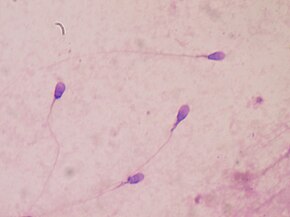This article includes a list of general references, but it lacks sufficient corresponding inline citations. (November 2016) |
| Semen analysis | |
|---|---|
 Human sperm stained for semen quality testing in the clinical laboratory | |
| MedlinePlus | 003627 |
| HCPCS-L2 | G0027 |
A semen analysis (plural: semen analyses), also called seminogram or spermiogram, evaluates certain characteristics of a male's semen and the sperm contained therein.[1][2][3] It is done to help evaluate male fertility, whether for those seeking pregnancy or verifying the success of vasectomy. Depending on the measurement method, just a few characteristics may be evaluated (such as with a home kit) or many characteristics may be evaluated (generally by a diagnostic laboratory). Collection techniques and precise measurement method may influence results. The assay is also referred to as ejaculate analysis, human sperm assay (HSA), sperm function test, and sperm assay.[citation needed]
Semen analysis is a complex test that should be performed in andrology laboratories by experienced technicians with quality control and validation of test systems. A routine semen analysis should include: physical characteristics of semen (color, odor, pH, viscosity and liquefaction), volume, concentration, morphology and sperm motility and progression. To provide a correct result it is necessary to perform at least two, preferably three, separate seminal analyses with an interval between them of seven days to three months.
The techniques and criteria used to analyze semen samples are based on the WHO manual for the examination of human semen and sperm-cervical mucus interaction published in 2021.[1]
- ^ a b "1. Introduction". WHO laboratory manual for the examination and processing of human semen (6th ed.). Geneva: World Health Organization. 2021. pp. 1–8. ISBN 978-92-4-003078-7.
- ^ de Guevara, Nicolás; Guiro, Miguel Angel Motos (2019). "1. Assisted reproductive technology in perimenopausal women". In Pérez-López, Faustino R. (ed.). Postmenopausal Diseases and Disorders. Switzerland: Springer. p. 7. ISBN 978-3-030-13935-3.
- ^ Koziol, J. H.; Armstrong, C. L. (2022). "1. Introduction". Sperm Morphology of Domestic Animals. Hoboken: Wiley Blackwell. p. 10. ISBN 978-1-119-76976-7.